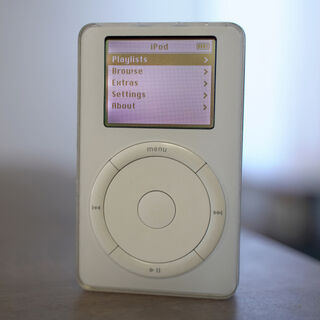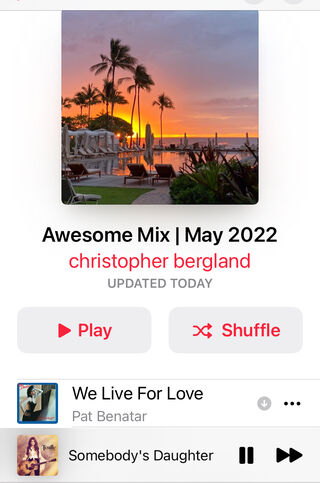Adolescence
8 Ways to Maximize Music's Motivational Power
Curate your own "Awesome Mix."
Posted May 13, 2022 Reviewed by Tyler Woods
Key points
- Our human ancestors evolved to run at an energy-efficient pace that conserved calories while chasing prey across the savannas.
- Joggers have trouble burning calories because our bodies evolved to seek this energy-saving pace.
- Music helps runners pick up the pace, but curating motivational playlists is tricky. Knowing how Disney chooses "Awesome Mix" songs can help.

New research (Selinger et al., 2022) suggests that human runners evolved to run at an energy-efficient pace that makes it difficult for most joggers to burn a lot of calories unless they make a concerted effort to run faster.
The good news for anyone who wants to lose weight or improve their fitness by doing vigorous running workouts is that motivational music can coax runners' feet to move faster than their "baked-in" energy-saving pace. If the beats per minute (BPM) of a song cause each foot strike to hit the ground at a faster tempo, you'll automatically run at a more intense calorie-burning pace.
But there are other factors beyond BPMs that influence music's motivational power. In this post, I'll share some road-tested ways I've learned to ensure that my favorite motivational music stays fresh and doesn't lose its oomph. Preserving the motivational power of music is key when you want to bottle a song's energy and use it on-demand to push yourself beyond the energy-saving pace that evolution baked into our biology.
The iPod Revolutionized How Joggers Use Motivational Music
I've been running to mixtapes and self-selected playlists religiously since the early 1980s, soon after the original Sony Walkman went on sale in 1979. Decades later, in 2004, I broke a Guinness World Record by running six back-to-back marathons in 24 hours while blasting my favorite self-selected music on a first-generation iPod, which Apple discontinued in May 2022.

Although it makes me nostalgic to see the antiquated iPod phased out, today's smartphones make it easy for us to stream workout music, tap on Shazam to identify unknown songs, and instantly save motivational music to self-selected playlists.
For this post, which combines evidence-based research and a first-person lived experience narrative, I've synthesized what goes into making motivational playlists that inspire me to push past my energy-efficient running pace by sharing how I curated my latest "Awesome Mix."
Deconstructing the Anatomy of a Motivational Playlist
On Saturdays, I like to do a 60-minute "tempo" run at a much faster speed than my typical energy-saving pace, which I prefer most days of the week. Jogging in my comfort zone feels good and allows my mind to declutter and connect the dots between seemingly unrelated ideas. In general, burning calories isn't the main reason I run. So, staying in an energy-efficient zone during my daily jogs suits my primary running objective, which is to cultivate superfluid thinking.
That said, once a week, I like to challenge myself by running fast and seeing how far I can go in 60 minutes. During these calorie-incinerating runs, I rely heavily on the crème de la crème of motivational music stored in my smartphone's music library. Like a fine wine, I keep my "power songs" stashed away on a playlist reserved exclusively for Saturday tempo runs and only play them once a week.

When curating my latest May 2022 motivational mix, I was inspired by reading about how Disney imagineers curated songs for the new Guardians of the Galaxy: Cosmic Rewind ride that opens at EPCOT on May 27.
For those unfamiliar with the role that Awesome Mixes play in this Marvel franchise: During all of his superhero adventures in outer space, the lead character, Peter Quill (a.k.a. "Star-Lord"), carries a collection of songs from the 1970s and early '80s known as "Awesome Mix vol. 1 and 2." These mixtape cassettes were made by Quill's mother when she was dying of cancer so that her son could live vicariously through the music that inspired her during her formative years.
When Disney's imagineers were developing an Awesome Mix soundtrack for the new Guardians of the Galaxy's "storycoaster" ride at EPCOT, they started with an eclectic list of 150 potential songs. Then, they narrowed this list down to a half dozen songs that fit perfectly with the "spirit and movement of the coaster."
Each of the 150 potential tunes was given a test ride on the coaster to see which ones worked best. Eventually, they narrowed the ride's Awesome Mix down to six classics: "September," "Conga," "Disco Inferno," "Everybody Wants to Rule the World," "I Ran," and "One Way or Another."
The storycoaster songs on EPCOT's latest attraction are played on shuffle, so theme-park riders won't know which Awesome Mix tracks they'll hear until the ride blasts off. One imagineer noted that "September" was his favorite track; another was surprised that he thought the slow-tempo Tears for Fears song worked best.
When I was curating my latest Saturday morning running mix, I took cues from how the imagineers approached choosing songs and decided to "test ride" lots of different music on the treadmill. My goal was to be highly selective and only put the absolute most inspiring tunes on this turbocharged playlist. Much like the imagineers were surprised by which songs actually worked on the ride, I was caught off guard by which music made the final cut.
For example, the live version of "The Weight" (featuring Mavis Staples) from The Last Waltz is a slow-tempo song, but the lyrics trigger tons of music-evoked emotions, and my feet hit the ground on every other beat in a way that keeps me running at a fast pace.
Another song that made the cut is "We Live for Love" by Pat Benatar. It was produced by Mike Chapman, who also produced "One Way or Another" by Blondie. Because I've heard Blondie's Greatest Hits so many times, they've lost their motivational gusto. But a quick search of Chapman's discography using the Discogs database reminded me of this 1979 album track by Benatar, which sounds almost exactly like a Blondie song but still feels fresh because it doesn't get overplayed.
Realizing how much I still love this Pat Benatar track from her first album, which became popular in 1980 (when I was 14), reminded me of a study that unearthed why the intensity of music-evoked autobiographical memories is most intense during this stage of adolescence. (See, "Why the Songs of Our Youth Trigger Such Intense Reminiscence.")
To find more songs that would give me a "reminiscence bump" from my teenage years, I went to Billboard's year-end charts and found some other long-forgotten tracks that I added to my latest Awesome Mix playlist.
Another song that made the cut for my latest Awesome Mix is "I Feel It" by Avid Dancer. I was unfamiliar with this 2015 track until a few weeks ago, when I heard it on an alternative rock station and "tapped Shazam." This app automatically saves queried songs to a "recently added" playlist that I referenced while curating my May 2022 Awesome Mix.
While scanning the dial a few days ago, I stumbled on a country station and Shazamed "Somebody's Daughter" by Tenille Townes, another surprisingly amazing running song. Shazam is an indispensable tool for getting unknown songs you randomly encounter in daily life uploaded to your music library.
8 Ways to Curate Motivational Playlists for Energy-Burning Workouts
In closing, below is an itemized list of the 8 key points covered in my autobiographical case study of putting together my latest Awesome Mix.
- Self-Selection Is Key: Research shows that runners are most inspired by self-selected songs. Streaming services are great for finding new workout songs, but you should save your favorites to a customized playlist that is a compilation of "your songs."
- BPM Isn't Everything: Conventional wisdom is that upbeat songs will help you run faster and burn more energy, but this isn't always the case. Sometimes, a slower song that triggers powerful music-evoked emotions can inspire you to pick up the pace.
- Be Selective About Your "Awesome Mix" Self-Selections: When Disney's imagineers were choosing songs for the "Cosmic Rewind" theme-park ride, they tested 150 songs on the coaster, but only six classics (4 percent) made the final cut. You should be just as selective when curating a personalized "Awesome Mix."
- Don't Overplay Your Faves: Treat a motivational anthem like fine wine: Store it in a special place and savor it. Whenever you replay a song with strong music-evoked autobiographical memories (MEAMs), the vividness of its nostalgic memories is diluted by recent listening experiences.
- Keep It Eclectic: Diversity (not just randomness) is the key to optimizing your personalized "Awesome Mix" when it's playing on shuffle mode. When curating a motivation playlist, try to include music from different genres and eras that evoke a wide range of salient emotions.
- Scour Billboard Year-End Charts: Because the music from adolescence gives us the most potent "Reminiscence Bumps," do a deep dive into the Billboard charts from when you were growing up to find long-forgotten songs that will make you feel young again.
- Shazam Unknown Songs: Use the Shazam app anytime you hear an unknown song and make sure your settings automatically save any Shazamed tracks to a "recently added" playlist.
- Research Discogs Database: Discogs is a crowdsourced database that you can use to find hidden gems by music producers and songwriters you like. For example, Keith Forsey co-wrote "Flashdance...What a Feeling" and produced Billy Idol's first two albums. I discovered his producer credits on Discogs.
Curating motivational playlists inspires me to push past my energy-efficient comfort zone. Using these techniques has worked for me over the years. Hopefully, some of these tips will work for you, too.
References
Jessica C. Selinger, Jennifer L. Hicks, Rachel W. Jackson, Cara M. Wall-Scheffler, Derek Chang, Scott L. Delp. "Running in the Wild: Energetics Explain Ecological Running Speeds." Current Biology (First published: April 28, 2022) DOI: 10.1016/j.cub.2022.03.076
Hui Kwan Nicholas Lam, Harry Middleton, Shaun M. Phillips. "The Effect of Self-Selected Music on Endurance Running Capacity and Performance in a Mentally Fatigued State." Journal of Human Sport and Exercise (First published online: June 22, 2021) DOI: 10.14198/jhse.2022.174.16
Kelly Jakubowski, Tuomas Eerola, Barbara Tillmann, Fabien Perrin, Lizette Heine. "A Cross-Sectional Study of Reminiscence Bumps for Music-Related Memories in Adulthood." Music & Science (First published online: October 23, 2020) DOI: 10.1177/2059204320965058
Emelia Michels-Ratliff and Michael Ennis. "This Is Your Song: Using Participants’ Music Preferences to Efficiently Evoke “High-Quality” Nostalgia that Includes Autobiographical Memories." Psychomusicology: Music, Mind, and Brain (First published: October 1, 2016) DOI: 10.1037/pmu0000167




